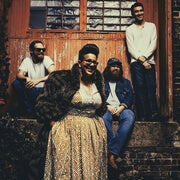Alabama Shakes
with Strand of Oaks
About Alabama Shakes: “We took our time to write this record, and I’m really glad we did,” says Brittany Howard, lead singer and guitarist of Alabama Shakes, about the band’s new album Sound & Color. “We were able to sit down and think about what’s exciting to us, explore all the things we wanted to on our first album. This record is full of genre-bending songs—it’s even harder now when people ask, ‘What kind of band are you?’ I have no clue.”
Sound & Color is the eagerly anticipated follow-up to the Shakes’ 2012 debut Boys & Girls, which earned the group three Grammy nominations, including a nod for Best New Artist. The gold-certified album’s breakthrough paved the way for the Shakes—Howard, guitarist Heath Fogg, bassist Zac Cockrell, drummer Steve Johnson, and touring keyboard players Ben Tanner and Paul Horton—to become one of the most celebrated live acts in the world, as they delivered unforgettable performances everywhere from Saturday Night Live to the main stages of such festivals as Bonnaroo and Glastonbury.
“There was definitely a slight wave of pressure after that success,” says Fogg, “but everyone was really on the same page about letting that pass and making the record that we wanted to make, trying to be creative and free and not limit ourselves.”
The album’s twelve songs reveal a band honed by years on the road, and drawing from a wide range of influences. The bluesy groove of “Shoegaze” or the garage-rock freak-out on “The Greatest” give way to the psychedelic space jam “Gemini.” The gently swaying, chiming title song opens the album with what Howard calls “more of a visual thing, I think of this whole scene going on,” then explodes into the urgent, tightly-coiled funk of “Don’t Wanna Fight.” Long instrumental intros and passages create hazy atmosphere, and then the intensity of Howard’s vocals snaps everything back into riveting focus.
About Strand Of Oaks:
From the first bars of HEAL, the exhilarating melodic stomp of "Goshen '97" puts you right into Tim Showalter's fervent teenage mindset. We find him in his family's basement den in Goshen, Indiana, feeling alienated but even at 15 years old, believing in the alchemy and power of music to heal your troubles. "The record is called HEAL, but it's not a soft, gentle healing, it's like scream therapy, a command, because I ripped out my subconscious, looked through it, and saw the worst parts. And that's how I got better." HEAL embodies that feeling of catharsis and rebirth, desperation and euphoria, confusion and clarity. It is deeply personal and unwittingly anthemic.
Showalter was on tour, walking back to his hotel on a mild autumn night in Malmo, Sweden, when he first felt the weight of the personal crisis that would ignite him to write HEAL. "It was a culmination of pressure," Showalter recalls. "My marriage was suffering, I'd released a record I was disappointed in, I didn't like how I looked or acted...so I'd gone on tour, I was gone about two years! I didn't take time to think about failure, but I knew I was going deeper and deeper...I was thinking, I have this life, but it's not my life, I haven't done it right..."
SHOWINGS
This event has already occurred.




